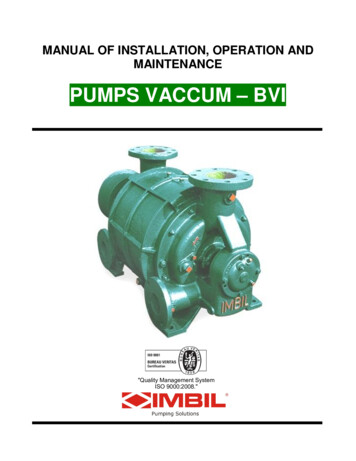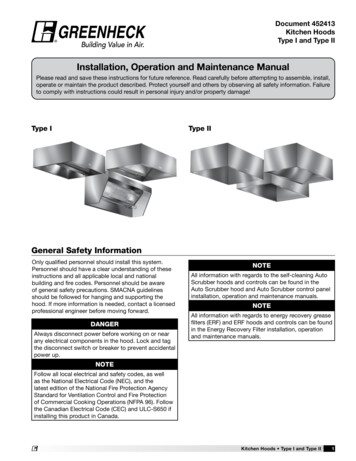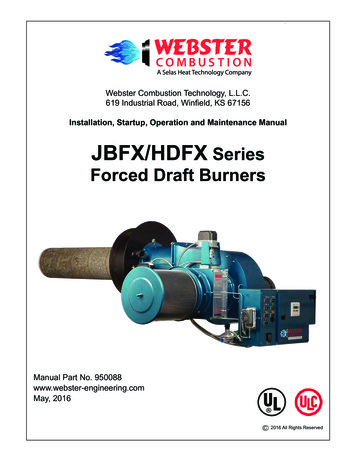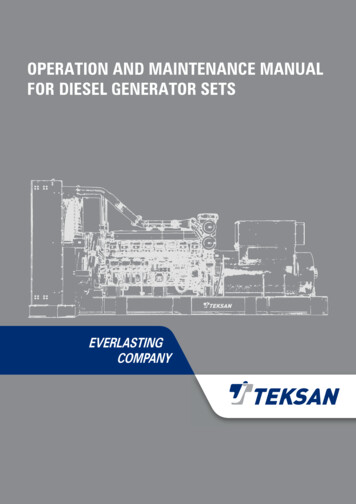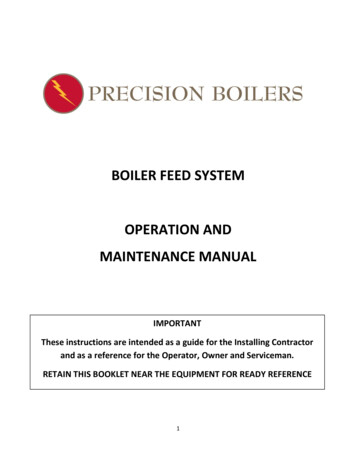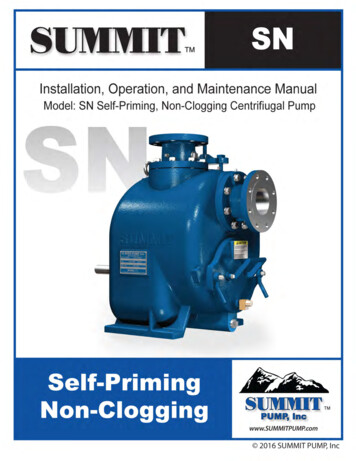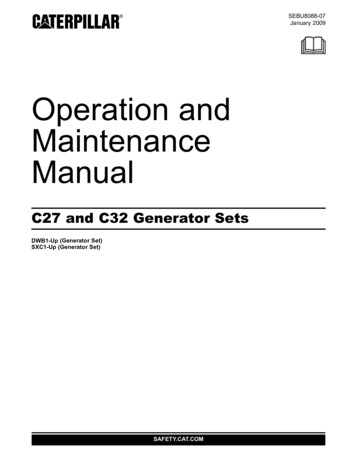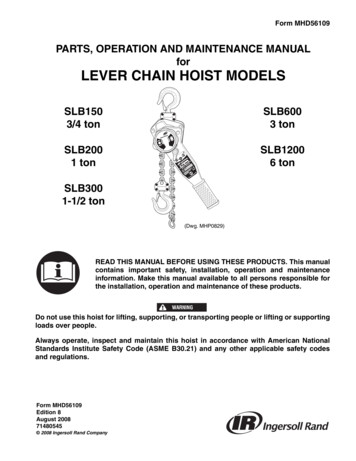
Transcription
Form MHD56109PARTS, OPERATION AND MAINTENANCE MANUALforLEVER CHAIN HOIST MODELSSLB1503/4 tonSLB6003 tonLOADFREESLB2001 tonSLB12006 tonSLB3001-1/2 ton(Dwg. MHP0829)READ THIS MANUAL BEFORE USING THESE PRODUCTS. This manualcontains important safety, installation, operation and maintenanceinformation. Make this manual available to all persons responsible forthe installation, operation and maintenance of these products.WARNINGDo not use this hoist for lifting, supporting, or transporting people or lifting or supportingloads over people.Always operate, inspect and maintain this hoist in accordance with American NationalStandards Institute Safety Code (ASME B30.21) and any other applicable safety codesand regulations.Form MHD56109Edition 8August 200871480545 2008 Ingersoll Rand Company
SAFETY INFORMATIONThis manual provides important information for all personnelinvolved with the safe installation, operation and propermaintenance of this product. Even if you feel you are familiarwith this or similar equipment, you should read this manualbefore operating the product.Danger, Warning, Caution and NoticeThroughout this manual there are steps and procedures which, ifnot followed, may result in a hazard. The following signal wordsare used to identify the level of potential hazard.DANGERIndicates an imminently hazardoussituation which, if not avoided, will resultin death or serious injury.WARNINGIndicates a potentially hazardous situationwhich, if not avoided, could result indeath or serious injury.CAUTIONIndicates a potentially hazardous situationwhich, if not avoided, may result in minoror moderate injury or property damage.NOTICEIndicates information or a companypolicy that relates directly or indirectly tothe safety of personnel or protection ofproperty.Safety SummaryIngersoll Rand hoists are manufactured in accordance with thelatest ASME B30.21 standards.WARNING Do not use this hoist for lifting, supporting, or transportingpeople or lifting or supporting loads over people. Hoists are designed to provide a 4 to 1 safety factor.Supporting structures and load-attaching devices used inconjunction with this hoist must provide adequate support tohandle all hoist operations, plus the weight of hoist andattached equipment. This is the customer’s responsibility. If indoubt, consult a registered structural engineer.The National Safety Council, Accident Prevention Manual forIndustrial Operations, Eighth Edition and other recognized safetysources make a common point: Employees who work near cranesor assist in hooking on or arranging a load should be instructed tokeep out from under the load. From a safety standpoint, one factoris paramount: conduct all lifting operations in such a manner thatif there were an equipment failure, no personnel would be injured.This means keep out from under a raised load and keep out of theline of force of any load.The Occupational Safety and Health Act of 1970 generally placesthe burden of compliance with the user, not the manufacturer.Many OSHA requirements are not concerned or connected withthe manufactured product but are, rather, connected with the finalinstallation. It is the owner’s and user’s responsibility todetermine the suitability of a product for any particular use. It isrecommended that all applicable industry, trade association,federal, state and local regulations be checked. Read all operatinginstructions and warnings before operation.Rigging: It is the responsibility of the operator to exercisecaution, use common sense and be familiar with proper riggingtechniques. Refer to ASME B30.9 for rigging information,American National Standards Institute, 1430 Broadway, NewYork, NY 10018.WARNING TAGEach hoist is supplied from the factory with a multi-languagewarning tag shown. If the tag is not attached to your unit, order anew tag and install it. Refer to parts list for part number. Read andobey all warnings and other safety information attached to thishoist. Tag may be shown smaller than actual size.2WARNINGFailure to follow these warnings may result indeath, severe injury or property damage: Read manual before using this product. Do not lift, lower or pull more thanrated load. Do not lift people or loads overpeople. Do not operate with twisted or damagedchain or kinked, frayed or cut rope or strap. Do not operate lever hoist or puller with handleextension (cheaters). Do not operate if damaged or malfunctioning. Do not operate when chain, rope or strap cannotform straight line with load. Do not operate with other than manual power. Do not operate with open latch, twisted hook orwithout a latch. Always keep minimum of 3 wraps of wire ropeor 2 wraps of strap on drum. Do not remove or obscure warning labels.MHD56109 - Edition 8
SAFE OPERATING INSTRUCTIONSThe following warnings and operating instructions have beenadapted in part from American National Standard ASME B30.21and are intended to avoid unsafe operating practices which mightlead to injury or property damage.Ingersoll Rand recognizes that most companies who use hoistshave a safety program in force in their plants. In the event thatsome conflict exists between a rule set forth in this publicationand a similar rule already set by an individual company, the morestringent of the two should take precedence.Safe Operating Instructions are provided to make an operatoraware of dangerous practices to avoid and are not necessarilylimited to the following list. Refer to specific sections in themanual for additional safety information.1.Only allow personnel trained in safety and operation of thisproduct to operate hoist.2. Only operate a hoist if you are physically fit to do so.3. When a “DO NOT OPERATE” sign is placed on hoist, donot operate hoist until sign has been removed by designatedpersonnel.4. Before each shift, the operator should inspect hoist for wearor damage.5. Never use a hoist which inspection indicates is worn ordamaged.6. Periodically, inspect hoist thoroughly and replace worn ordamaged parts. Refer to “INSPECTION” section.7. Lubricate hoist regularly. Refer to “LUBRICATION”section.8. Do not use hoist if hook latch has been sprung or broken.9. Check that hook latches are engaged before using.10. Never splice a hoist chain by inserting a bolt between links.11. Only lift loads less than or equal to rated capacity of hoist.Refer to “SPECIFICATIONS” section.12. Never use hoist load chain as a sling.13. Never operate a hoist when load chain is not centered undertop hook. Do not “side pull” or “yard.”14. Never operate a hoist with twisted, kinked, “capsized” ordamaged load chain.15. Do not force a chain or hook into place by hammering.16. Never insert point of hook into a chain link.17. Be certain load is properly seated in saddle of hook and hooklatch is engaged.18. Do not support load on tip of hook.19. Never run load chain over a sharp edge. Use a sheave.20. When using two hoists to suspend one load, select two hoistseach having a rated capacity equal to or more than the load.This provides adequate safety in the event of a sudden loadshift.21. Pay attention to the load at all times when operating hoist.22. Always ensure that you, and all other people, are clear ofload path. Do not lift a load over people.23. Never use hoist for lifting or lowering people, and neverallow anyone to stand on a suspended load.24. Ease slack out of chain and sling when starting a lift. Do notjerk the load.25. Do not swing a suspended load.26. Do not leave a load suspended when hoist is unattended ornot in use.27. Never weld or cut on a load suspended by the hoist.28. Never use hoist chain as a welding electrode.29. Do not operate hoist if chain jumping, excessive noise,jamming, overloading, or binding occurs.30. Keep load from hitting load chain.31. Do not use a cheater bar or extended handle.32. Never place hand inside throat area of a hook.33. After use, or when in a non-operational mode, hoist shouldbe secured against unauthorized and unwarranted use.34. Only operate hoist with manual power.SPECIFICATIONSGeneralModel Code ExplanationThe Lever Chain Hoist can be mounted to the suspension shaft ofa trolley or a permanent mounting structure. The hoist is designedto lift and lower loads up to rated capacity with minimal levereffort.Example:SLB-300-15SeriesHoist CapacityLift (Hoist load chain/hook travel)To determine hoist configuration refer to capacity and lot numbernameplate located on hand lever for model number information.SeriesSLB Silver Lever HoistMHD56109 - Edition 8Hoist Capacity150 3/4 metric ton / 750 kg200 1 metric ton / 1,000 kg300 1-1/2 metric ton / 1,500 kg600 3 metric ton / 3,000 kg1200 6 metric ton / 6,000 kgLift15 5 m (standard)20 6 mXX Specify lengthF Hoist without load chainOptionsS Shipyard Hook3
Specifications TableModelNo.Capacity(metric tons)Lever Pull to liftrated load 27242426LoadChain size (mm)Wt. of chain per0.3 m of lift (kg)6 x 180.247.1 x 21.2No. of chainfalls7.0310.341.661.3210 x 30Hoist Net Weightwith standard1.5 m of lift (kg)11.020.030.42INSTALLATIONPrior to installing hoist, carefully inspect it for possible shippingdamage. Hoists are supplied fully lubricated from the factory.Ensure load chain is lubricated prior to hoist operation.NOTICE Each time a load is lifted, operation of load brake should bechecked by raising load slightly and stopping to ensure brakewill hold load before continuing to lift load. Owners and users are advised to examine specific, local orother regulations, including American National StandardsInstitute and/or OSHA Regulations, which may apply to aparticular type of use of this product, before installing orputting hoist to use.Top HookHook LatchThe SLB lever chain hoist can be used in any position provided itis rigged to pull in a straight line from top hook to bottom hook.DFREELOACAUTIONFree KnobSelector LeverThe hoist body must be positioned so that it does not contact theload or support members when in use. Ensure hand levermovement is unrestricted.Load Chain(Hook side)When operating in limited areas suitable lifting attachments orslings must be used to prevent hoist body and hand lever frombeing obstructed.BottomHookChain StopperCAUTIONHand LeverLoad Chain(Anchor side)(Dwg. MHP0830) Ensure hoist top and bottom hooks are properly rigged andhook latches are engaged, prior to use.Initial Operating ChecksFamiliarize operators and personnel responsible for hoistinstallation and service with ASME B30.21 specifications andthis manual prior to placing unit into service. All requirements ofthis specification, including testing should be met beforeapproving hoist for operation.Operate hoist with a test load (10% of rated capacity) by raisingand lowering this load several times. Verify brake operation bylowering same load to check load does not slip when loweringstops.OPERATIONThe four most important aspects of hoist operation are:1. Follow all safety instructions when operating hoist.2. Allow only personnel trained in safety and operation of thishoist to operate hoist.3. Subject each hoist to a regular inspection and maintenanceprocedure.4. Be aware of hoist capacity and weight of load at all times.Positioning Unloaded Hook (Neutral Position)Refer to Dwg. MHP0830 on page 4.Check that chain stopper (54) is securely fastened in last link ofload chain anchor end. The load chain stopper is intended toprevent load chain from becoming disengaged from hoist and isnot intended to support the load.WARNING The hoist is not designed or suitable for lifting, lowering ormoving persons. Never lift loads over people.4MHD56109 - Edition 8
Lowering Load (DOWN Position - Payout)CAUTIONRefer to Dwg. MHP0825 on page 5. Ensure load is properly seated in saddle of bottom hook.In NEUTRAL “N” position hand lever does not engage ratchetgear. The hand lever free-wheels until selector lever is shifted toUP or DOWN position.1. Set selector lever to NEUTRAL (center) position.2. Turn free chain knob counterclockwise.3. Grasp and pull one side of load chain or turn free knob untildesired hook location is achieved.4. Connect hook to load. Pull anchor side of load chain or turnfree knob until chain slack is removed.WARNING Do not continue lowering load after chain stopper hascontacted hoist body as damage may occur to hoist resulting ina falling load which can cause severe injury, death or propertydamage.The following procedure assumes hoist selector lever is in UPposition, hoist is holding a load and the operator wants to lower(payout) the load:1. Place selector lever in DOWN position.2. Rotate (ratchet) hand lever in counterclockwise direction tolower (payout) load.WARNING Do not support or hang loads from load chain anchor end.Brake may not hold load or operate correctly.CAUTIONLifting Load (UP Position - Haul-In) To prevent injury or property damage always lower loadsuntil load chain becomes slack before shifting to NEUTRALposition.Refer to Dwg. MHP0825 on page 5.The following procedure assumes hoist is in NEUTRAL (center)position and hook is attached to a load, but hoist is not supportingthe load.1. Place selector lever in UP position.2. Rotate free knob clockwise.3. Pull anchor end of load chain until slack is removed.4. Rotate (ratchet) hand lever in clockwise direction to raise(haul-in) load.Storing the Hoist1.2.3.4.5.6.NOTICEAlways store hoist in a no load condition.Switch selector lever to NEUTRAL (center position).Wipe off all dirt and water.Oil the chain, hook pins and hook latch pins.Hang in a dry place.Before returning hoist to service follow instructions for‘Hoists not in Regular Use’ in “INSPECTION” section. Ratchet may not engage and raise (haul-in) load until allchain slack is removed and hoist is supporting load weight. Ifhand lever movement does not produce lifting, apply tensionto anchor side of load chain while ratcheting until slack isremoved and hoist begins lifting load. If hoist does not operateproperly under load, rem
latest ASME B30.21 standards. WARNING Do not use this hoist for lifting, supporting, or transporting people or lifting or supporting loads over people. Hoists are designed to provide a 4 to 1 safety factor. Supporting structures and load-attaching devices used in conjunction with this hoist must provide adequate support to handle all hoist operations, plus the weight of hoist and .


